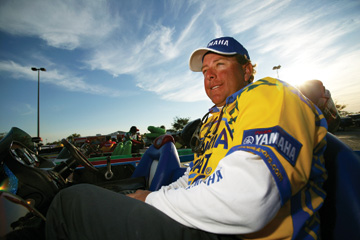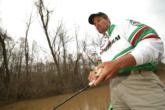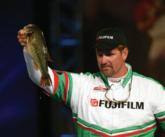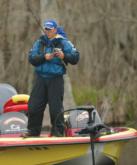Top dogs
Rojas and Swett stay on top of their game by using the oldest baits around: top-waters

Decades ago, top-water baits provided the bulk of bass action because few alternatives existed. Even today, few fishing possibilities excite anglers more than watching a wake homing in on a surface target or shattering still, shallow water in finned fury.
A big lunker smashing a top-water bait always pumps angling adrenaline because bass do not just hit or suck down top-water baits as they would a worm. They pulverize floaters with intense hatred that radiates across the lake surface.
“Top-water baits are a fun way to fish,” said Dean Rojas, a Yamaha pro from Grand Saline, Texas. “It’s all visual. We can see the fish and tell how big they are. Top-waters and buzzbaits are my key lures to use to find patterns and search for fish. When a fish blows up on a top-water bait and misses, I throw right back in there. If it doesn’t hit the top-water again, I follow up with a smaller bait or any type of shad bait.”
In the old days, carved wooden plugs produced many big fish and won many tournaments, but they eventually yielded to spinnerbaits, crankbaits and other baits. More recently, anglers began targeting previously untapped, deep, unseen structure with a myriad of soft-plastic creations. As people learned to catch bass in deep water, they often neglected their top-water baits.
Although bass go deep, some largemouths never leave shallow water. Weedy shallows may offer more oxygen than cold depths. Bass are shallow-water hunters by design. Black and green camouflage hides them in weedy cover. Their mouths face forward, unlike bottom feeders with downward-pointing mouths. With eyes on top of their heads, they see better when looking up. They can more easily spot baits silhouetted against the sky than they can detect creatures crawling around on a dark or weedy bottom.
 “When a fish makes a big explosion on a top-water bait, it makes my day,” said Sam Swett, a Fujifilm pro from Kissimmee, Fla. “Everyone gets caught up in using new baits. Bass get accustomed to seeing certain baits. Top-water baits are some of the oldest baits around, but they are still very effective. If people pull out some of the old baits that worked 30 years ago, they can catch fish because bass haven’t seen them much lately. Some of the oldest baits are Lucky 13s, Hula Poppers and Jitterbugs, but they still work today.”
“When a fish makes a big explosion on a top-water bait, it makes my day,” said Sam Swett, a Fujifilm pro from Kissimmee, Fla. “Everyone gets caught up in using new baits. Bass get accustomed to seeing certain baits. Top-water baits are some of the oldest baits around, but they are still very effective. If people pull out some of the old baits that worked 30 years ago, they can catch fish because bass haven’t seen them much lately. Some of the oldest baits are Lucky 13s, Hula Poppers and Jitterbugs, but they still work today.”
While people probably throw more top-waters in the spring, when bass move shallow to spawn, the fall can produce outstanding action, too. Cooling air creates more comfortable water temperatures until winter arrives. Additionally, bass find more food in the shallows. Minnows and shad hug shorelines, burrow into weed patches or hide among fallen trees or rocks. Crawfish crawl along the bottom. Worms wash into lakes after a rain. Bream make beds in sandy shallows.
“Top-water baits are much better in the fall,” Swett said. “In the fall, water starts cooling off near the surface. I like to throw top-waters when the water temperature starts dropping below 80 degrees. When it reaches the mid-50s, it usually becomes too cold for top-water baits, but I’ve caught bass on top-waters in water as cold as 45 degrees.”
As winter approaches, bass gorge themselves on shad and other baitfish. Often, they herd shad into balls and rip at them from all sides. Predators chase shad toward the surface to cut off their escape. In even the deepest channels, top-waters might still work, as bass clobber baitfish on the surface.
Walking baits, such as Zara Spooks, Top Dogs, Frenzy Walkers, Spit’n Images and similar lures, work like dynamite on schooling fish. Anglers can work them fast and cover considerable tracts of water as the baits zigzag from side to side with a “walking” motion. Create this continuous motion by making short but brisk flicks of a wrist. They simulate sick or wounded baitfish struggling on the surface.
 “My first choice for schooling fish is a Zara Spook,” Swett said. “When the water is calm, I like to throw a walking bait because the action gives a good, steady cadence. On Spooks, I like to replace the tail hook with a feathered hook. A hook dressed with a chicken feather gives it a little more action. It almost looks like a tail swimming or a fin. It makes the bait look more like a fish swimming along the surface.”
“My first choice for schooling fish is a Zara Spook,” Swett said. “When the water is calm, I like to throw a walking bait because the action gives a good, steady cadence. On Spooks, I like to replace the tail hook with a feathered hook. A hook dressed with a chicken feather gives it a little more action. It almost looks like a tail swimming or a fin. It makes the bait look more like a fish swimming along the surface.”
Poppers or chuggers displace water with concave nose surfaces. When jerked, they pop, chug or gurgle with considerable commotion. Poppers require slow, deliberate movement. Pop them once and then stop, letting baits remain motionless until the ripples fade. Then repeat the maneuver.
Somewhat resembling stunned frogs or other creatures thrashing on the surface, poppers or chuggers work well on choppy days or in murky water. Since they produce significant noise, they work exceptionally well at night. Some examples include Jitterbugs, Hula Poppers, Lucky 13s, Pop-Rs, Chug Bugs, Skitter Pops, Frenzy Poppers and Spitfires.
On choppy days or in murky water, many anglers also use prop baits such as Tiny Torpedoes, Skitter Pops, Devil’s Horses and other floaters with propellers. Prop baits come equipped with nose or rear propellers. Some employ propellers on both ends for more action. Propellers thrash the surface as anglers retrieve the baits.
“There are times when bass want thrashing on the surface and times when they want something more subtle gliding through the water,” Rojas said. “When it’s slick calm, I usually use a walking bait. When there’s a ripple on the water, I usually use a prop bait or chugger to cause more of a commotion.”
Since prop baits make plenty of noise, they also work well at night. The harder you jerk them, the more noise they make. Anglers can retrieve them with a steady motion, almost like a floating buzzbait, or use the stop-and-go approach. Experiment with both methods to see what fish prefer. Sometimes, bass like to study baits before striking. At other times, buzzing propellers provoke quick reaction strikes.
 “In the fall, I like to throw top-waters around grass and wood,” Rojas said. “I love prop baits because fish don’t see a lot of them. A prop bait is an excellent bait to use around grass. I rip it and then let it sit in pockets. I only move it 6 to 8 inches so it stays in the strike zone longer. I’ve had success when I’ve just steadily reeled prop baits so they make a `vee’ in the water. It’s almost like a buzzbait. At other times, I rip it and pause until I figure out what the fish want.”
“In the fall, I like to throw top-waters around grass and wood,” Rojas said. “I love prop baits because fish don’t see a lot of them. A prop bait is an excellent bait to use around grass. I rip it and then let it sit in pockets. I only move it 6 to 8 inches so it stays in the strike zone longer. I’ve had success when I’ve just steadily reeled prop baits so they make a `vee’ in the water. It’s almost like a buzzbait. At other times, I rip it and pause until I figure out what the fish want.”
Among the oldest and simplest bass lures ever invented, top-water baits remain on the market, some for nearly a century, because they still work. They still make the heart palpitate like few “modern” lures can.
Going soft for hard-to-reach lunkers
While technically not top-water baits, Texas-rigged soft plastics make effective surface enticements. Lizards, shads, slugs and similar soft baits sink slowly, but anglers can work them across the surface of weedy or snaggy waters where other lures cannot go.
 Often rigged without a weight, or perhaps with just a tiny split-shot to help with casting, these soft lures look like natural forage as they skitter across impenetrable salads. Light and lifelike, floating or slow-sinking soft plastics combine the attributes of fast top-water action with the fish-finding abilities of buzzbaits and the weedless enticement of Texas-rigged creatures. Bass see these baits silhouetted against the sky and slobber to attack them.
Often rigged without a weight, or perhaps with just a tiny split-shot to help with casting, these soft lures look like natural forage as they skitter across impenetrable salads. Light and lifelike, floating or slow-sinking soft plastics combine the attributes of fast top-water action with the fish-finding abilities of buzzbaits and the weedless enticement of Texas-rigged creatures. Bass see these baits silhouetted against the sky and slobber to attack them.
Fish soft plastics on or near the surface with two basic methods. Use a steady retrieve like a buzzbait, or try a “stop-sink-go” approach. For a steady retrieve, toss a bait across thickly matted cover. Hold the rod tip high and crank the reel slowly to make the bait slither across the surface or dance over weeds with a continuous motion. Often, bass explode through matted vegetation to attack these baits.
Tails and legs disrupt the surface to attract fish. In matted cover, use streamlined selections that easily slice through weeds. Popular curly tails may wrap around pad stems. Split-tailed plastics resemble frogs kicking across weeds.
In patchy cover, try the “stop-sink-go” approach. Cast to a likely spot and let it remain briefly motionless. Depending upon hook size and cover thickness, it might sink slowly. Pull it a couple feet and let it rest again. Let it twitch and sink into pockets a foot or two before “crawling” it over new pads or grass. On pads, let it sit briefly. After a few moments, ease it off the edge and let it sink into another pocket.